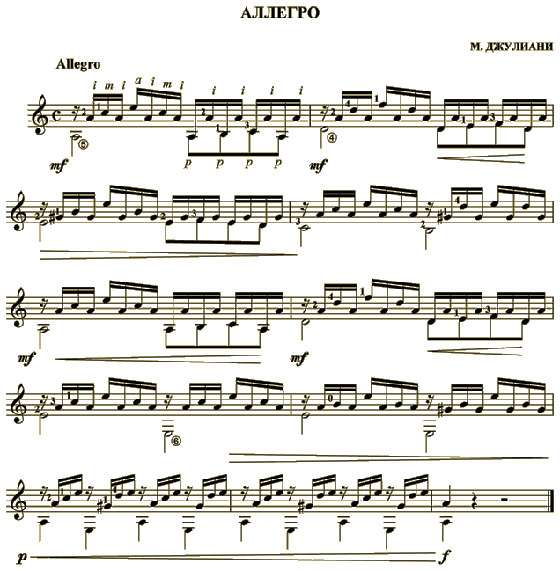
“Allegro” M. Giuliani, sheet music for beginners
“Tutorial” Guitar Lesson No. 10
How to play “Allegro” on the guitar
Allegro by the Italian guitarist and composer Mauro Giuliani, written on the basis of a simple and beautiful guitar picking already familiar to you from previous lessons, can rightly be called “Guitar Solo”. Despite its simplicity, this piece gives the impression of a full-fledged acoustic guitar solo. The bass lines, emphasized by the accompaniment on the third string, give an original variety to a simple piece for guitar. Allegro Giuliani is so popular that it is included in most tutorials and schools written for the guitar by both famous foreign and Russian guitarists-teachers. Beginning guitarists, when learning Giuliani’s allegro, should pay attention to the evenness of the performance of this work. Rhythmic evenness is what gives a simple guitar piece its true beauty. Do not rush with the tempo of the performance, everything will come with time – the main thing is to play smoothly, so that both the enumeration and the bass move with accompaniment are equally rhythmically even. Try to play slowly and according to the metronome, thereby controlling the rhythmic accuracy of the performance. The letter C written next to the treble clef is a four-quarter time signature, that is, there are 4 beats in each measure. Set the metronome to four beats, or if you don’t have a metronome, count each bar (one and two and three and four and). You can also use the online metronome on the Internet. When you learn to play slowly and evenly, without noticing for yourself, add the pace of performance and Giuliani’s allegro will acquire its charm in your performance precisely in the Allegro tempo. The name “Allegro” (translated from Italian cheerfully, joyfully) is directly related to the tempo of the performance. On mechanical metronomes, it is written out with a certain number of beats per minute (from 120 to 144). When performing “Allegro” by M. Giuliani, pay attention to the dynamic shades displayed under the musical line (Dynamic shades – the topic of the previous lesson).


Allegro Giuliani. Video
PREVIOUS LESSON #9 NEXT LESSON #11





